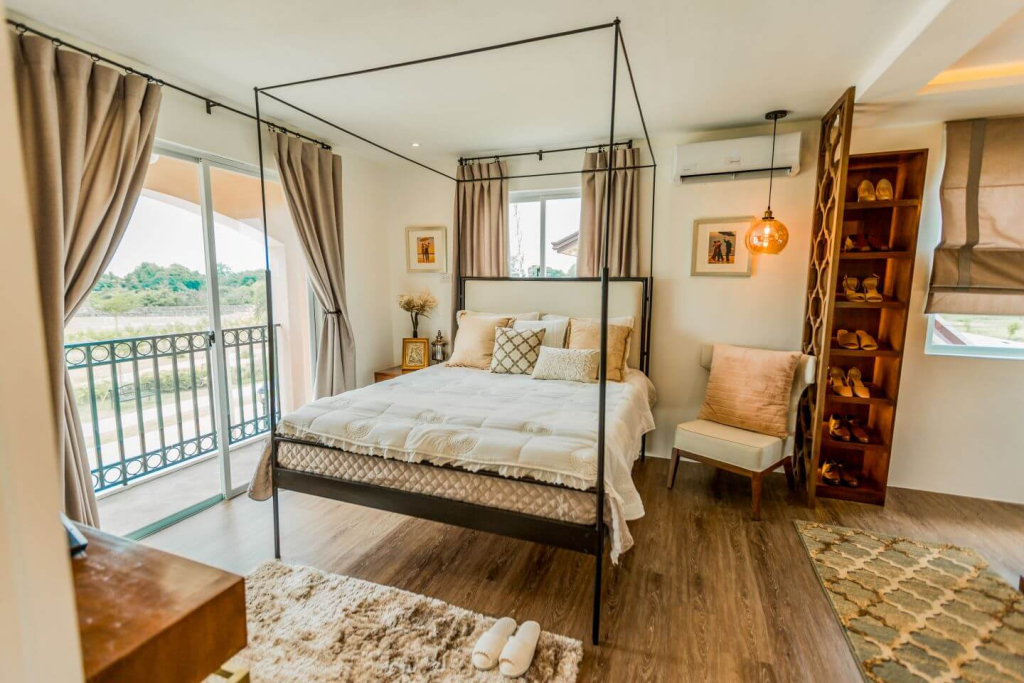
Image source: Freepik
Designing a bedroom that feels timeless and appealing to every generation is one of the most rewarding challenges in home living. Each stage of life carries its own rhythm—children seek adventure, adults crave balance, and seniors value ease and familiarity. Bringing these needs together in one cohesive space requires careful planning, a thoughtful understanding of function, and an appreciation for design that endures.
As one designer suggests, when a bedroom balances form and practicality, it becomes a sanctuary for growth, reflection, and connection. This guide explores how to design a bedroom for every generation, combining expert advice and tested design principles for homes that evolve gracefully through time.
Blending Styles and Atmosphere Through Interior Design
As we move from individual preferences to shared aesthetics, the question becomes: how do you blend diverse tastes across generations? The answer lies in the harmony of interior design.
A grandparent’s classic style, a parent’s minimalist touch, and a teenager’s playful creativity can all coexist when guided by balance and tone. The goal is to merge elements such as color, texture and light, into one cohesive story.
The Beauty of Flowy Curtains and Soft Lighting
Nothing ties a bedroom together quite like atmosphere. Flowy curtains, soft lighting, and elegant table lamps introduce a sense of calm across age groups. Layering these touches adds an additional layer of texture and warmth, allowing the space to adapt from morning brightness to evening serenity.
Try using pendant lights for visual symmetry and accentuating natural light whenever possible. Combine soft light with a neutral color palette for a soothing environment. Whether in a family home or a starter apartment, these small adjustments create continuity across styles and generations.
Finding Inspiration and Adding Personal Touches
While timeless design starts with structure, character blooms through personalization. Finding inspiration often begins at home—family heirlooms, travel mementos, or artwork can all inspire your color scheme or décor choices.
Include other elements like art, pillows, rugs, and wall décor to reflect your story. Incorporating abstract art above the headboard or an accent rug under the bed can act as the finishing touch that completes the aesthetic.
Keep in mind: personal touches shouldn’t clutter the room. They should highlight it. Choose pieces that make you feel grounded and connected—a framed photograph, a favorite chair, or handmade ceramics that remind you of family gatherings.
The Foundation of Timeless Bedroom Designs for Multiple Purposes
Today’s interior designers understand that a successful bedroom must do more than look beautiful; it must create comfort, offer flexibility, and suit the changing lifestyles of the people who occupy the space.
In family homes, this flexibility is essential. Whether it’s an older parent sharing space with adult children or young professionals working remotely, a bedroom’s function shifts as life changes. That’s why the foundation must include three things: clean lines, a neutral color palette, and functional furniture. These design choices establish calm, provide enough space for essentials, and make it easier to layer new styles over time.
A timeless bedroom design also values balance. The goal isn’t just to fill the room but to make every piece serve a purpose. From the bed frame to the lighting plan, every element should work harmoniously to support both rest and activity.
The Role of the Bed Frame and Headboard in Defining Style
At the center of any bedroom stands the bed frame—the piece that defines its character and comfort. Whether crafted from wood, metal, or upholstered fabric, the bed sets the focal point of the space. A sturdy bed frame supports restful sleep, while its design influences the entire atmosphere of the room.
For younger generations, minimal or Scandinavian-inspired frames with clean lines create an uncluttered feel. Adults may prefer upholstered or wooden frames that add warmth and structure, while seniors often appreciate lower frames that make getting in and out of bed easier.
Pairing the bed with a thoughtful headboard enhances its visual weight. Upholstered headboards soften the look, while wooden ones lend timeless elegance.
Choosing an Accent Wall for Personality
For families decorating on a budget, even a painted accent wall or a panel of textured wood behind the bed can mimic a designer finish without overspending. The accent wall is one of the simplest yet most effective ways to bring personality into a bedroom. A well-placed color on otherwise plain white walls adds a layer of depth without overwhelming the space.
Keep the tones subtle with muted greens, dusty blues, or warm taupes ensure the design remains appealing to all ages. For those who want to add artistry, a panel of abstract art or a soft wallpaper pattern can add a big impact without clutter.
Another example is adding some texture to the walls. Wainscoting, wooden slats, or even upholstered panels give visual rhythm to a wall and complement any design style.
Making the Bedroom Serve Multiple Purposes
As homes evolve, bedrooms now serve multiple purposes. They can double as home offices, reading nooks, or small relaxation corners. The key is versatility.
Foldable desks, modular furniture, and pieces with built-in drawers help maintain order and store essentials discreetly. Functional furniture with hidden storage space ensures a neat environment while maximizing the floor area.
Lighting also makes all the difference in this transformation. A task light or well-placed table lamps can shift the room from rest mode to work mode easily. Adjustable pendant lights above a study corner can also help improve focus. With these smart inclusions, even a small space can feel balanced, productive, and restful at once.
Maximizing Space in a Small Bedroom
Once the foundation is set, the next challenge is space, especially in homes where every square meter matters. Moving from overall design to spatial planning, small bedrooms require creativity and discipline. Even when space is limited, there’s no need to compromise on style. The secret lies in smart organization and proportion.
Smart Storage Solutions
In compact rooms, we can’t forget that clutter is the enemy of comfort. Clever storage space can keep a small bedroom functional without sacrificing aesthetics.
Built-in drawers under the bed are a practical solution, especially when paired with floating shelves or headboards that double as cubbies. Vertical cabinets make use of higher wall areas while keeping the floor clear, giving the illusion of more space.
Interior designers often recommend a balance between open and closed storage. Open shelves display favorite art pieces, while closed drawers hide personal essentials. The combination ensures order while preserving warmth.
Layout and Vertical Space Planning
When every inch counts, layout decisions have a big impact. Position the bed where natural light flows freely, ideally beside a window framed by flowy curtains. This makes the room appear larger and more inviting.
Use vertical design to draw the eye upward. Wall-mounted table lamps or adjustable sconces free the bedside tables, adding both style and function. Keep clean lines throughout to maintain visual openness, and if the budget allows, choose built-in cabinets that align seamlessly with the wall.
The result is a great place that feels airy, intentional, and adaptable. This is proof that good design doesn’t depend on size.
Creating Private Spaces for Every Generation
Once you’ve maximized functionality, the next step is to personalize. Every generation values private spaces—rooms where they can rest, reflect, and reconnect with themselves. A well-designed bedroom fosters individuality while maintaining harmony across the household.
In communities like Camella Solano in Solano, Nueva Vizcaya, this balance comes naturally. Homes are designed with flexible layouts that support both shared and personal zones. Within a single house, families can nurture connection while preserving privacy—something essential in multigenerational living. Here are a few ideas on how to achieve this:
Kids and Teens: Designing for Energy and Expression
For kids and teens, the bedroom is a playground of imagination. Here, fun shapes design decisions. Bright rugs, playful throw pillows, and personalized accents turn the space into a world of creativity.
Since their interests change quickly, choose adaptable décor. Removable wallpaper, interchangeable fabrics, and lightweight furniture make it easy to update the room as they grow. Add a compact desk for homework, and ensure enough space remains for movement and play.
Adults: Serenity Through Simplicity
Adults often seek rest after busy days. For them, serenity begins with clean lines and a neutral color palette. Simple wooden furniture, soft-textured bedding, and symmetrical bedside tables create a sense of calm.
Avoid excessive décor; instead, let tactile materials and balanced proportions define the space. A tranquil adult bedroom acts as both a sanctuary and a place of mental clarity.
Seniors: Comfort, Accessibility, and Warmth
For older generations, comfort and accessibility outweigh all else. Ensure enough space to move around safely, with non-slip floors and clear pathways between the bed, chairs, and storage areas.
Position lighting within reach, ideally with switch-controlled table lamps beside the bed. Soft fabrics and cushioned surfaces provide warmth, while supportive seating makes everyday routines easier. The best design style for seniors prioritizes safety without sacrificing beauty—proof that thoughtful details can enhance both function and dignity.
The Finishing Touch: Connection and Comfort Across Generations
At this point, design meets emotion. The final measure of a great bedroom is how it makes people feel.
True timelessness comes from spaces that invite connection and comfort. A well-planned bedroom gives every generation a sense of belonging, reflecting the life and dreams shared under one roof. From thoughtfully arranged storage, gentle soft lighting, and cozy beds, every detail contributes to making a house feel like home.
Decorating together can also strengthen family ties. Allow children to pick colors, let adults choose furniture, and involve seniors in layout decisions. This shared process ensures every member feels represented, making the final space a reflection of collective creativity and care.
Conclusion
Ultimately, learning how to design a bedroom for every generation is about blending design with empathy. It’s about seeing the room as a story of shared lives—beautiful, functional, and enduring. And when those principles come together, the result is more than just elegant interiors; it’s a timeless space where every generation finds its place, comfort, and connection.

Celebrate Life’s Milestones in Camella!
Make unforgettable memories in a Camella home.
Our communities are designed to elevate your living experience.

